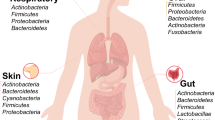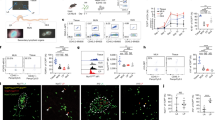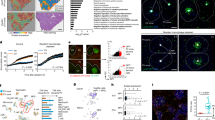Abstract
The gut microbiota regulates levels of serotonin (5-hydroxytryptamine (5-HT)) in the intestinal epithelium and lumen1,2,3,4,5. However, whether 5-HT plays a functional role in bacteria from the gut microbiota remains unknown. We demonstrate that elevating levels of intestinal lumenal 5-HT by oral supplementation or genetic deficiency in the host 5-HT transporter (SERT) increases the relative abundance of spore-forming members of the gut microbiota, which were previously reported to promote host 5-HT biosynthesis. Within this microbial community, we identify Turicibacter sanguinis as a gut bacterium that expresses a neurotransmitter sodium symporter-related protein with sequence and structural homology to mammalian SERT. T. sanguinis imports 5-HT through a mechanism that is inhibited by the selective 5-HT reuptake inhibitor fluoxetine. 5-HT reduces the expression of sporulation factors and membrane transporters in T. sanguinis, which is reversed by fluoxetine exposure. Treating T. sanguinis with 5-HT or fluoxetine modulates its competitive colonization in the gastrointestinal tract of antibiotic-treated mice. In addition, fluoxetine reduces the membership of T. sanguinis in the gut microbiota of conventionally colonized mice. Host association with T. sanguinis alters intestinal expression of multiple gene pathways, including those important for lipid and steroid metabolism, with corresponding reductions in host systemic triglyceride levels and inguinal adipocyte size. Together, these findings support the notion that select bacteria indigenous to the gut microbiota signal bidirectionally with the host serotonergic system to promote their fitness in the intestine.
This is a preview of subscription content, access via your institution
Access options
Access Nature and 54 other Nature Portfolio journals
Get Nature+, our best-value online-access subscription
$29.99 / 30 days
cancel any time
Subscribe to this journal
Receive 12 digital issues and online access to articles
$119.00 per year
only $9.92 per issue
Buy this article
- Purchase on Springer Link
- Instant access to full article PDF
Prices may be subject to local taxes which are calculated during checkout




Similar content being viewed by others
Data availability
Data generated or analysed during this study are included in this published article and its Supplementary Information files. Structural modelling files that support the findings of this study are available from Zenodo with the identifier 10.5281/zenodo.3266444. The 16S rDNA sequencing data that support the findings of this study are available from the Qiita database with study IDs 12585, 12596 and 12597, and are also available in the Supplementary Tables. Bacterial transcriptomic data that support the findings of this study are available in Gene Expression Omnibus repository with the accession number GSE133810 and are also available in the Supplementary Tables. Intestinal transcriptomic data that support the findings of this study are available in the Gene Expression Omnibus repository with the accession number GSE133809 and are also available in the Supplementary Tables.
References
Vuong, H. E., Yano, J. M., Fung, T. C. & Hsiao, E. Y. The microbiome and host behavior. Annu. Rev. Neurosci. 40, 21–49 (2017).
Gershon, M. D. & Tack, J. The serotonin signaling system: from basic understanding to drug development for functional GI disorders. Gastroenterology 132, 397–414 (2007).
Reigstad, C. S. et al. Gut microbes promote colonic serotonin production through an effect of short-chain fatty acids on enterochromaffin cells. FASEB J. 29, 1395–1403 (2015).
Wikoff, W. R. et al. Metabolomics analysis reveals large effects of gut microflora on mammalian blood metabolites. PLoS ONE 106, 3698–3703 (2009).
Yano, J. M. et al. Indigenous bacteria from the gut microbiota regulate host serotonin biosynthesis. Cell 161, 264–276 (2015).
Sjogren, K. et al. The gut microbiota regulates bone mass in mice. J. Bone Min. Res. 27, 1357–1367 (2012).
Hata, T. et al. Regulation of gut luminal serotonin by commensal microbiota in mice. PLoS ONE 12, e0180745 (2017).
Fujimiya, M., Okumiya, K. & Kuwahara, A. Immunoelectron microscopic study of the luminal release of serotonin from rat enterochromaffin cells induced by high intraluminal pressure. Histochem. Cell Biol. 108, 105–113 (1997).
Mawe, G. M. & Hoffman, J. M. Serotonin signalling in the gut—functions, dysfunctions and therapeutic targets. Nat. Rev. Gastroenterol. Hepatol. 10, 473–486 (2013).
Chen, J. J. et al. Maintenance of serotonin in the intestinal mucosa and ganglia of mice that lack the high-affinity serotonin transporter: abnormal intestinal motility and the expression of cation transporters. J. Neurosci. 21, 6348–6361 (2001).
Olivella, M., Gonzalez, A., Pardo, L. & Deupi, X. Relation between sequence and structure in membrane proteins. Bioinformatics 29, 1589–1592 (2013).
Coleman, J. A. & Gouaux, E. Structural basis for recognition of diverse antidepressants by the human serotonin transporter. Nat. Struct. Mol. Biol. 25, 170–175 (2018).
Forrest, L. R., Tavoulari, S., Zhang, Y. W., Rudnick, G. & Honig, B. Identification of a chloride ion binding site in Na+/Cl−-dependent transporters. Proc. Natl Acad. Sci. USA 104, 12761–12766 (2007).
Barker, E. L., Moore, K. R., Rakhshan, F. & Blakely, R. D. Transmembrane domain I contributes to the permeation pathway for serotonin and ions in the serotonin transporter. J. Neurosci. 19, 4705–4717 (1999).
Solis, E. Jr. et al. 4-(4-(dimethylamino)phenyl)-1-methylpyridinium (APP+) is a fluorescent substrate for the human serotonin transporter. J. Biol. Chem. 287, 8852–8863 (2012).
Chanrion, B. et al. Physical interaction between the serotonin transporter and neuronal nitric oxide synthase underlies reciprocal modulation of their activity. Proc. Natl Acad. Sci. USA 104, 8119–8124 (2007).
Seimandi, M. et al. Calcineurin interacts with the serotonin transporter C-terminus to modulate its plasma membrane expression and serotonin uptake. J. Neurosci. 33, 16189–16199 (2013).
Ramijan, K. et al. Stress-induced formation of cell wall-deficient cells in filamentous actinomycetes. Nat. Commun. 9, 5164 (2018).
Browne, H. P. et al. Culturing of ‘unculturable’ human microbiota reveals novel taxa and extensive sporulation. Nature 533, 543–546 (2016).
Goodrich, J. K., Davenport, E. R., Waters, J. L., Clark, A. G. & Ley, R. E. Cross-species comparisons of host genetic associations with the microbiome. Science 352, 532–535 (2016).
Geva-Zatorsky, N. et al. Mining the human gut microbiota for immunomodulatory organisms. Cell 168, 928–943 (2017).
Miyazaki, M., Dobrzyn, A., Elias, P. M. & Ntambi, J. M. Stearoyl-CoA desaturase-2 gene expression is required for lipid synthesis during early skin and liver development. Proc. Natl Acad. Sci. USA 102, 12501–12506 (2005).
Porter, N. T., Canales, P., Peterson, D. A. & Martens, E. C. A subset of polysaccharide capsules in the human symbiont Bacteroides thetaiotaomicron promote increased competitive fitness in the mouse gut. Cell Host Microbe 22, 494–506 (2017).
Lyte, M., Villageliu, D. N., Crooker, B. A. & Brown, D. R. Symposium review: microbial endocrinology—why the integration of microbes, epithelial cells, and neurochemical signals in the digestive tract matters to ruminant health. J. Dairy Sci. 101, 5619–5628 (2018).
Jackson, M. A. et al. Gut microbiota associations with common diseases and prescription medications in a population-based cohort. Nat. Commun. 9, 2655 (2018).
Goodrich, J. K. et al. Genetic determinants of the gut microbiome in UK twins. Cell Host Microbe 19, 731–743 (2016).
Bernstein, C. N. & Forbes, J. D. Gut microbiome in inflammatory bowel disease and other chronic immune-mediated inflammatory diseases. Inflamm. Intest. Dis. 2, 116–123 (2017).
Guo, X. et al. High fat diet alters gut microbiota and the expression of Paneth cell-antimicrobial peptides preceding changes of circulating inflammatory cytokines. Mediat. Inflamm. 2017, 9474896 (2017).
Lee, S. H., Paz-Filho, G., Mastronardi, C., Licinio, J. & Wong, M. L. Is increased antidepressant exposure a contributory factor to the obesity pandemic? Transl. Psychiatry 6, e759 (2016).
Beyazyuz, M., Albayrak, Y., Egilmez, O. B., Albayrak, N. & Beyazyuz, E. Relationship between SSRIs and metabolic syndrome abnormalities in patients with generalized anxiety disorder: a prospective study. Psychiatry Invest. 10, 148–154 (2013).
Abdala-Valencia, H. et al. Inhibition of allergic inflammation by supplementation with 5-hydroxytryptophan. Am. J. Physiol. Lung Cell Mol. Physiol. 303, L642–L660 (2012).
Caporaso, J. G. et al. Global patterns of 16S rRNA diversity at a depth of millions of sequences per sample. Proc. Natl Acad. Sci. USA 108, 4516–4522 (2011).
Caporaso, J. G. et al. QIIME allows analysis of high-throughput community sequencing data. Nat. Methods 7, 335–336 (2010).
Langille, M. G. et al. Predictive functional profiling of microbial communities using 16S rRNA marker gene sequences. Nat. Biotechnol. 31, 814–821 (2013).
Katoh, K., Rozewicki, J. & Yamada, K. D. MAFFT online service: multiple sequence alignment, interactive sequence choice and visualization. Brief Bioinform. https://doi.org/10.1093/bib/bbx108 (2017).
Robinson, O., Dylus, D. & Dessimoz, C. Phylo.io: interactive viewing and comparison of large phylogenetic trees on the web. Mol. Biol. Evol. 33, 2163–2166 (2016).
Kelley, L. A., Mezulis, S., Yates, C. M., Wass, M. N. & Sternberg, M. J. The Phyre2 web portal for protein modeling, prediction and analysis. Nat. Protoc. 10, 845–858 (2015).
Webb, B. & Sali, A. Comparative protein structure modeling using MODELLER. Curr. Protoc. Protein Sci. 86, 2.9.1–2.9.37 (2016).
Berman, H. M. et al. The Protein Data Bank. Nucleic Acids Res. 28, 235–242 (2000).
Stamm, M., Staritzbichler, R., Khafizov, K. & Forrest, L. R. AlignMe—a membrane protein sequence alignment web server. Nucleic Acids Res. 42, W246–W251 (2014).
Wallner, B. ProQM-resample: improved model quality assessment for membrane proteins by limited conformational sampling. Bioinformatics 30, 2221–2223 (2014).
Laskowski, R. A., Rullmannn, J. A., MacArthur, M. W., Kaptein, R. & Thornton, J. M. AQUA and PROCHECK-NMR: programs for checking the quality of protein structures solved by NMR. J. Biomol. NMR 8, 477–486 (1996).
Best, R. B. et al. Optimization of the additive CHARMM all-atom protein force field targeting improved sampling of the backbone ϕ, ψ and side-chain χ1 and χ2 dihedral angles. J. Chem. Theory Comput. 8, 3257–3273 (2012).
Phillips, J. C. et al. Scalable molecular dynamics with NAMD. J. Comput. Chem. 26, 1781–1802 (2005).
Williams, C. J. et al. MolProbity: more and better reference data for improved all-atom structure validation. Protein Sci. 27, 293–315 (2018).
Ashkenazy, H. et al. ConSurf 2016: an improved methodology to estimate and visualize evolutionary conservation in macromolecules. Nucleic Acids Res. 44, W344–W350 (2016).
Pettersen, E. F. et al. UCSF Chimera—a visualization system for exploratory research and analysis. J. Comput. Chem. 25, 1605–1612 (2004).
Coleman, J. A., Green, E. M. & Gouaux, E. X-ray structures and mechanism of the human serotonin transporter. Nature 532, 334–339 (2016).
Jeong, J. Y. et al. One-step sequence- and ligation-independent cloning as a rapid and versatile cloning method for functional genomics studies. Appl. Environ. Microbiol. 78, 5440–5443 (2012).
Hiemke, C. & Hartter, S. Pharmacokinetics of selective serotonin reuptake inhibitors. Pharm. Ther. 85, 11–28 (2000).
McClure, R. et al. Computational analysis of bacterial RNA-Seq data. Nucleic Acids Res. 41, e140 (2013).
Huang, D. W., Sherman, B. T. & Lempicki, R. A. Systematic and integrative analysis of large gene lists using DAVID bioinformatics resources. Nat. Protoc. 4, 44–57 (2009).
Szklarczyk, D. et al. The STRING database in 2017: quality-controlled protein–protein association networks, made broadly accessible. Nucleic Acids Res. 45, D362–D368 (2017).
Schindelin, J. et al. Fiji: an open-source platform for biological-image analysis. Nat. Methods 9, 676–682 (2012).
Love, M. I., Huber, W. & Anders, S. Moderated estimation of fold change and dispersion for RNA-Seq data with DESeq2. Genome Biol. 15, 550 (2014).
Bligh, E. G. & Dyer, W. J. A rapid method of total lipid extraction and purification. Can. J. Biochem. Physiol. 37, 911–917 (1959).
Acknowledgements
We thank members of the Hsiao Laboratory and G. Donaldson for critical review of the manuscript; R. Kaback (UCLA), D. Yang and E. Gouaux (Vollum Institute, OHSU), K. C. Huang (Stanford), M. Quick and J. Javitch (Columbia University) for helpful advice; J. Murowski, D. Nusbaum and J. Yano (UCLA) for assistance with the initial pilot experiments; Y. Wang and J. F. Miller (UCLA) for providing Bacteroides strains and expression constructs; K. Williams (UCLA Lipidomic Core Facility) for performing lipidomic measurements; P. Bradley and R. Gunsalus (UCLA) for facilitating the radioisotope experiments; and G. Karsenty (Columbia), Y. Tintut (UCLA) and F. Bäckhed (University of Gothernburg) for providing the Tph1 mice and tissue samples. Support for this research was provided by the NIH Director’s Early Independence Award (5DP5OD017924) to E.Y.H., Klingenstein-Simons Award to E.Y.H., Packard Fellowship in Science and Engineering to E.Y.H., UCLA Postdocs’ Longitudinal Investment in Faculty Training Award (K12 GM106996) to H.E.V., Ruth L. Kirschstein National Research Service Award (AI007323) to G.N.P. and Division of Intramural Research of the NIH (National Institute of Neurological Disorders and Stroke) to L.R.F. All data and materials used to understand and assess the conclusions of this research are available in the main text and Supplementary Materials.
Author information
Authors and Affiliations
Contributions
T.C.F. performed the bacteriology, sequencing experiments and data analysis. C.D.G.L. and A.V. assisted with the bacteriology experiments. T.C.F., H.E.V. and G.N.P. performed the mouse experiments. A.A.A., N.G.R. and L.R.F. performed the structural modelling. J.M. and T.R. generated the gnotobiotic mice. L.R.F. and E.Y.H. contributed to the data analysis. T.C.F., L.R.F. and E.Y.H. supervised the study. T.C.F. and E.Y.H. wrote the manuscript. All authors reviewed and edited the final version of the text.
Corresponding authors
Ethics declarations
Competing interests
The authors declare no competing interests. Findings regarding the host effect of T. sanguinis reported in the manuscript are the subject of a provisional patent application (US 62/815,760), owned by UCLA.
Additional information
Publisher’s note: Springer Nature remains neutral with regard to jurisdictional claims in published maps and institutional affiliations.
Supplementary information
Supplementary Information
Supplementary Figs. 1–19.
Supplementary Tables
Supplementary Tables 1–11.
Supplementary Dataset 1
Protein structural model of CUW_0748 from T. sanguinis MOL361, based on the available structure of human SERT (Protein Data Bank entry 5i6x chain A).
Rights and permissions
About this article
Cite this article
Fung, T.C., Vuong, H.E., Luna, C.D.G. et al. Intestinal serotonin and fluoxetine exposure modulate bacterial colonization in the gut. Nat Microbiol 4, 2064–2073 (2019). https://doi.org/10.1038/s41564-019-0540-4
Received:
Accepted:
Published:
Issue Date:
DOI: https://doi.org/10.1038/s41564-019-0540-4
This article is cited by
-
Microbiota–gut–brain axis and its therapeutic applications in neurodegenerative diseases
Signal Transduction and Targeted Therapy (2024)
-
Multi-omics reveal microbial determinants impacting the treatment outcome of antidepressants in major depressive disorder
Microbiome (2023)
-
Cefaclor causes vagus nerve-mediated depression-like symptoms with gut dysbiosis in mice
Scientific Reports (2023)
-
The olfactory receptor Olfr78 promotes differentiation of enterochromaffin cells in the mouse colon
EMBO Reports (2023)
-
Gut microbiota Turicibacter strains differentially modify bile acids and host lipids
Nature Communications (2023)



